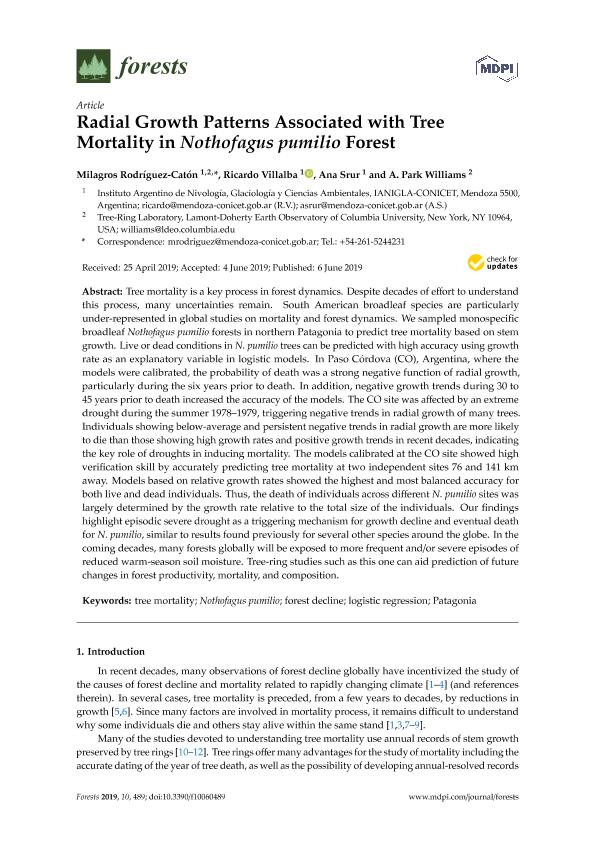Artículo
Radial growth patterns associated with tree mortality in Nothofagus pumilio forest
Fecha de publicación:
06/2019
Editorial:
Molecular Diversity Preservation International
Revista:
Forests
ISSN:
1999-4907
Idioma:
Inglés
Tipo de recurso:
Artículo publicado
Clasificación temática:
Resumen
Tree mortality is a key process in forest dynamics. Despite decades of effort to understand this process, many uncertainties remain. South American broadleaf species are particularly under-represented in global studies on mortality and forest dynamics. We sampled monospecific broadleaf Nothofagus pumilio forests in northern Patagonia to predict tree mortality based on stem growth. Live or dead conditions in N. pumilio trees can be predicted with high accuracy using growth rate as an explanatory variable in logistic models. In Paso Córdova (CO), Argentina, where the models were calibrated, the probability of death was a strong negative function of radial growth, particularly during the six years prior to death. In addition, negative growth trends during 30 to 45 years prior to death increased the accuracy of the models. The CO site was affected by an extreme drought during the summer 1978-1979, triggering negative trends in radial growth of many trees. Individuals showing below-average and persistent negative trends in radial growth are more likely to die than those showing high growth rates and positive growth trends in recent decades, indicating the key role of droughts in inducing mortality. The models calibrated at the CO site showed high verification skill by accurately predicting tree mortality at two independent sites 76 and 141 km away. Models based on relative growth rates showed the highest and most balanced accuracy for both live and dead individuals. Thus, the death of individuals across different N. pumilio sites was largely determined by the growth rate relative to the total size of the individuals. Our findings highlight episodic severe drought as a triggering mechanism for growth decline and eventual death for N. pumilio, similar to results found previously for several other species around the globe. In the coming decades, many forests globally will be exposed to more frequent and/or severe episodes of reduced warm-season soil moisture. Tree-ring studies such as this one can aid prediction of future changes in forest productivity, mortality, and composition.
Archivos asociados
Licencia
Identificadores
Colecciones
Articulos(IANIGLA)
Articulos de INST. ARG. DE NIVOLOGIA, GLACIOLOGIA Y CS. AMBIENT
Articulos de INST. ARG. DE NIVOLOGIA, GLACIOLOGIA Y CS. AMBIENT
Citación
Rodriguez Catón, Milagros Rocío; Villalba, Ricardo; Srur, Ana Marina; Williams, A. Park; Radial growth patterns associated with tree mortality in Nothofagus pumilio forest; Molecular Diversity Preservation International; Forests; 10; 6; 6-2019; 1-18
Compartir
Altmétricas




